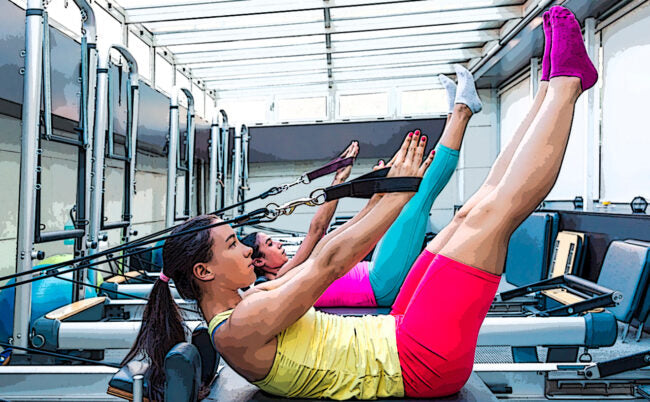Many women aim to have a flatter and fuller stomach. Their approach is then to do abs to strengthen their abdominal muscles. But in this quest, they too often neglect other essential muscles: those of the pelvic floor (also called perineum).
In synergy with the deep abdominal muscles, the perineal area ensures good support and optimal functioning of the trunk. Considering this, it is therefore interesting to do hypopressive abs by including the work of the perineum in the exercises. In practice, here is how to harmonize the pelvic floor and abs:
A little anatomy: the close relationship between perineum and abdominals
Let’s start first with a quick anatomical point. What exactly are abdominal muscles? And the pelvic floor ? Finally, what relationship do they have, especially in women?
When you think of abs, you probably visualize the famous “six-pack.” But in reality, this is just the tip of the iceberg. Called “rectus majors”, these superficial abdominals are also accompanied by other muscles which support the bust. With the obliques (external and internal) and the transverse muscle, they form the abdominal strap.
Together, they make it possible to:
- Make all involuntary movements of the chest: breathing, sneezing, coughing or even vomiting.
- Perform voluntary movements of the trunk: flexion (forward, backward, lateral), rotation and stabilization of the spine.
- Contain the intra-abdominal pressure inside the bust. This is what keeps the trunk straight and protects the organs and the spine.
To ensure these vital functions, the abdominal muscles then need good support at the base of the trunk. This is where the pelvic floor comes in. Forming a sort of muscular hammock, it helps support the viscera and control the sphincters. Thus, the perineum completes the work of the woman's abs.

Working in synergy
In practice, the deep abdominal muscle (the transverse) and the pelvic floor must work in synergy. When they contract at the same time, they provide better support for the organs, pelvis and lower back. A stronger and better coordinated abdominal and perineum also limit many risks. For example, the risks ofincontinence, pelvic pain, organ descent, sexual dysfunction, diastasis, etc.
Finally, this synchronized contraction must also be done naturally in rhythm with the breathing. But some people have difficulty coordinating perineum, deep abs and diaphragm. In her case, the pressure in the abdomen is then too great, which leads to the risks listed above.
Fortunately, it is possible to exercise all these muscles to (re)teach them how to work together.

Best Hypopressive Abdominal Exercises
The aim is above all to work the deep muscles of the trunk, mainly with exercises hypopressive abs. Unlike hyperpressives – raised bust type – they do not exert pressure forwards or downwards. They thus preserve the pelvic floor and gently strengthen the abdominal strap.
Now let's take a look at the best ab exercises for women:
Sheathing
Classic or side plank, on the hands or forearms, legs extended or knees on the ground… Hold the position for 20 seconds, then gradually increase the duration.
Glute bridge or pelvic raise
Arms alongside your body, legs bent and feet anchored in the ground, raise your pelvis as you exhale. Hold the position (isometric version) or lower then raise the pelvis, varying the tempo.

Asymmetrical sheathing
On all fours, extend one arm and the opposite leg, tightening the abdominal strap. Hold for at least 20 seconds before exchanging.
Here are also 3 variations in motion:
- Raise and lower the limbs slowly, 10 times in a row.
- Spread them outwards, then bring them back in line with the body.
- Bend them by contracting the abdominals, then tense them again.
Bear board
Still on all fours, lift your knees slightly off the ground. Hold the pose for at least 20 seconds. To make the exercise more complex, you can also take off your hands or feet alternately.

Tips for strengthening your abdominal muscles
In practice, apply these tips for all previous exercises:
- Before contracting, take a deep breath, then exhale to release all the air from the lungs.
- Contract the perineum from the bottom upwards, pulling in the stomach.
- Hold well during postures and movements. Imagine sucking your navel toward your spine, keeping your stomach tucked in.
- Control your breathing and align your movements with those of your diaphragm.
Women's abs: what postpartum exercise?
Finally, we also have the more specific case of young mothers. After childbirth – by natural route or cesarean section – it is recommended to do a perineal rehabilitation. Indeed, pregnancy is quite traumatic for the pelvic floor and abdominals.
On the one hand, the perineum had to support an increasing weight over the months. Then during childbirth, it stretched enormously to allow the passage of the baby. It is even possible that it suffered a tear and/or a episiotomy.

On the other hand, the abdominal muscles also stretched throughout pregnancy. Especially in recent months, the recti have moved aside to leave as much room as necessary for the baby. This is called diastasis.
Perineal rehabilitation and strengthening of the transverse muscle
Although these phenomena are natural and unavoidable, they put a strain on a woman's abs. This is why it is necessary to make a postpartum perineal rehabilitation.
In general, healthcare professionals advise waiting at least 6 to 8 weeks after giving birth. Some pregnant women even take the initiative by exercising from the moment they are pregnant.
In all cases, seek the advice of a gynecologist, physiotherapist or midwife before starting. And above all, it is important to re-educate your perineum before returning to sport
When you have the green light, only bet on hypopressive abdominals. So forget about crunch-type bust lifts, which risk accentuating the separation of the rectus abdominis.
On the contrary, favor exercises that strengthen the transverse muscle: located horizontally, it will help to tighten diastasis. And above all, work your abs and your perineum in synergy, while controlling your breathing.
Finally, there is no particular type of exercise after cesarean. You can do abs the same way as after a vaginal birth. The most important thing is to have doctor’s approval.
Practice daily
By focusing on strengthening and coordinating your deep abs and pelvic floor, you will improve your pelvic health. Exercise every day, for better comfort throughout your life! And don't forget, certain sports are better than others for strengthening your perineum.
Taking care of your perineum and regularly practicing abdominal exercises on a daily basis is crucial for maintain health and pelvic floor stability. This makes it possible to promote the prevention of problems such as urinary incontinence and prolapse.
These habits also contribute to strengthen the abdominal belt, improving posture and reducing the risk of lower back pain. By integrating these practices into your routine, you support a solid physical foundation, essential for an active and fulfilling life.





